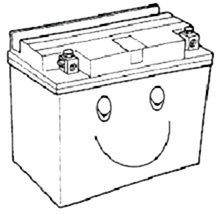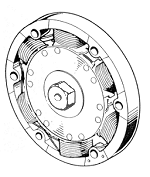|
 Dead batteries got you down? Like to fix your motorcycle or ATV charging system yourself? Here is where you start. Dead batteries got you down? Like to fix your motorcycle or ATV charging system yourself? Here is where you start.
The basics
Most of us know that electricity is easily generated mechanically. All you need is a magnet, a coil of wire, and motion. Therefore, a motorcycle's charging system is very simple. In fact, that's mostly what it is--wire, magnets, and motion. Nevertheless, many do-it-yourselfers are frustrated in their attempts at fixing their sick charging systems. If you're one of them, take heart--it isn't entirely your fault. The deal has been rigged from the beginning. There are secrets to charging system troubleshooting that only the industry insiders are privy to. The awkward fact is, everyone who understands motorcycle charging systems well enough to proficiently troubleshoot them has had to come to terms with the following three seldom-considered facts. (It takes most mechanics years to realize these things--you're getting it all in one lesson!)
The manual is no help
First, the industry's manuals don't help much. Though workshop manuals usually offer a lot of individual electrical tests, most--including the factories'--fall woefully short of making the tests make sense. You may in fact fix something, but you will probably not know why. That's because there is no systematic thought in the tests. As a result, you will be no better prepared the next time. You won't have learned anything. And by the way, don't expect too much from your local repair shop. They're often just as confused as you are. You'll have to teach yourself.
The industry's terminology is confusing
Unfortunately, that can be quite difficult, because the second thing you must realize is that the industry has erected barriers to learning about its electrical systems. The powersports industry has traditionally departed from the rules governing the general motor trade. There are more variations in charging system design in motorcycles, ATVs, scooters, snowmobiles, and personal watercraft than in any other vehicle type. What's worse, there is little consistency in the terminology surrounding these systems, not  only throughout the entire powersports industry, but in just the motorcycle segment of the industry. Motorcycle manufacturers have never agreed among themselves on what they call the various charging system components. The car guys by contrast are far more disciplined. The auto industry follows Society of Automotive Engineers nomenclature guidelines. However, powersports manufacturers follow nobody. Not even themselves. Some change even their own terminology from one year to the next! Therefore, you will find it exceedingly difficult to see the logical links between charging system types, links that might otherwise help you educate yourself. They're there, but the manufacturers have consciously downplayed them. This situation calls for a special approach, a departure from the standard instructional method. Our exploration of this topic will consequently be marked by independent thinking. This includes the use of generic, non-proprietary terminology, as an aid to learning. That is, function-oriented names for things rather than their conventional, manufacturer-specific ones. It's the only way that makes sense for you the outsider. only throughout the entire powersports industry, but in just the motorcycle segment of the industry. Motorcycle manufacturers have never agreed among themselves on what they call the various charging system components. The car guys by contrast are far more disciplined. The auto industry follows Society of Automotive Engineers nomenclature guidelines. However, powersports manufacturers follow nobody. Not even themselves. Some change even their own terminology from one year to the next! Therefore, you will find it exceedingly difficult to see the logical links between charging system types, links that might otherwise help you educate yourself. They're there, but the manufacturers have consciously downplayed them. This situation calls for a special approach, a departure from the standard instructional method. Our exploration of this topic will consequently be marked by independent thinking. This includes the use of generic, non-proprietary terminology, as an aid to learning. That is, function-oriented names for things rather than their conventional, manufacturer-specific ones. It's the only way that makes sense for you the outsider.
Charging systems are actually very simple
The third and final point is that there is hope. The motorcycle's charging system is one of the simplest vehicle electrical systems there is. So simple that, despite the dozens of different system configurations, all the motorcycle charging systems on the planet can be grouped into just two basic types. For more, get my booklet, Honda SOHC Four Charging, available on my website, www.motorcycleproject.com.
|

 ®
®

 ®
®